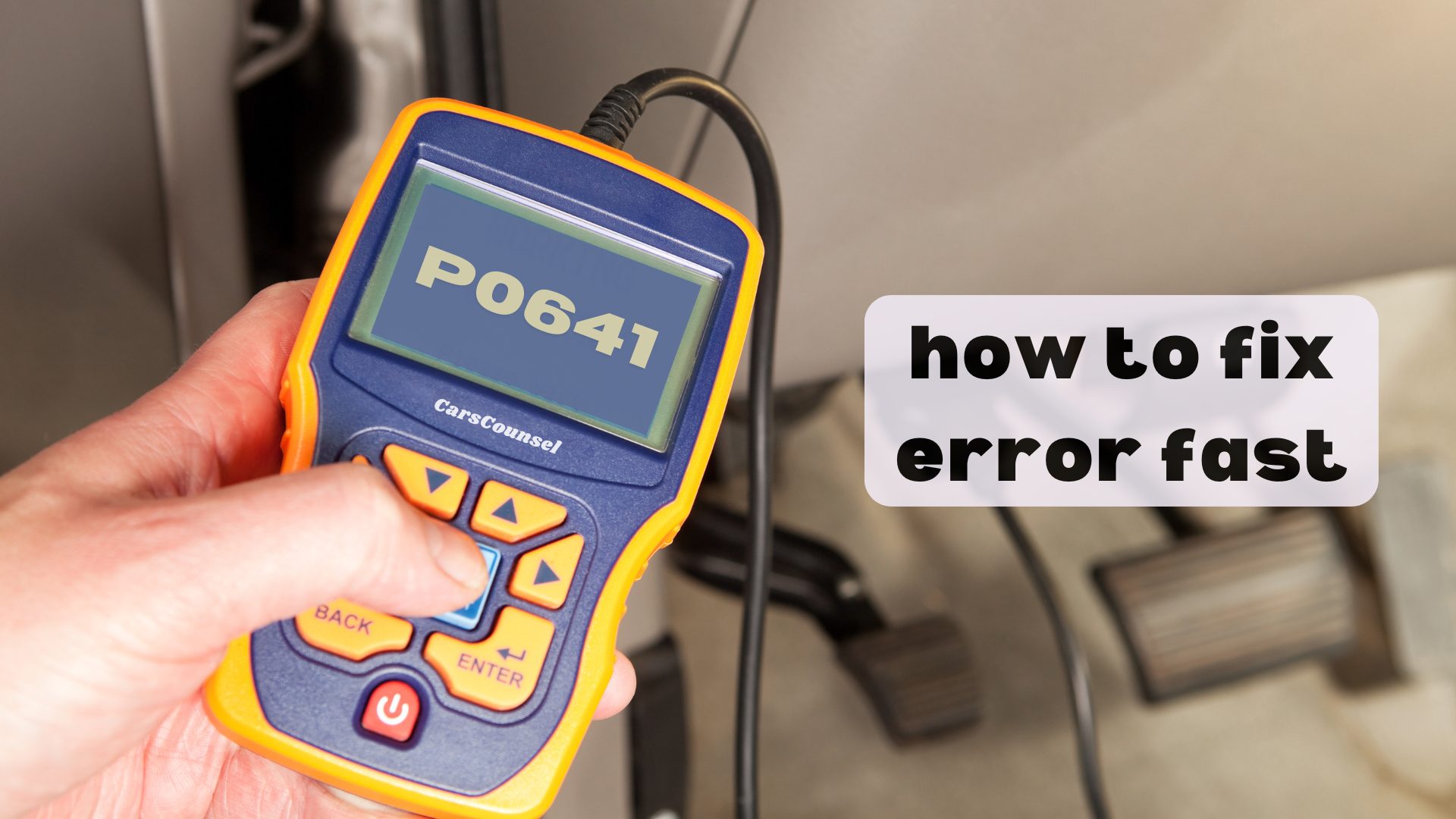Picture this: you’re driving your 2015 Chevy Malibu and the check engine light comes on. You find out it’s a P0641 code, which means there’s an issue with the sensor reference voltage circuit. This could mess with your car’s performance.
To fix it quickly, check the wiring and connectors for any damage or rust, and use a multimeter to test the reference voltage.
But what if the OBD2 problem doesn’t go away after you’ve done all that? Knowing the next steps can save you time and help prevent more serious damage to your car’s engine control unit.

Quick Navigation
Key Takeaways
- Check the wiring for any damage, rust, or loose connections in the sensor’s voltage circuit.
- Use a diagnostic tool to check and monitor the sensor’s voltage levels in real-time.
- Clean and tighten all electrical connectors to make sure they’re making good contact and allowing proper voltage flow.
- Use a multimeter to test the sensors and make sure they’re giving the correct voltage readings.
Understanding P0641 Code
The P0641 code means there’s a problem with the sensor reference voltage A circuit, which indicates the voltage isn’t what it should be according to the manufacturer. This usually means there’s an issue in the sensor reference circuit, leading to incorrect voltage readings.
To address this, start by checking your vehicle’s Powertrain Control Module (PCM) as it might be sending wrong signals.
Then, use a diagnostic tool to check the sensor reference voltage and see if it matches the required values. If there are any differences, look at the wiring for any signs of damage, corrosion, or loose connections. Make sure all connectors are clean and properly connected.
Following these steps will help you find and fix the problem quickly and efficiently.
Common Symptoms
If you have a P0641 code, you’ll likely notice some clear signs that something’s wrong with your car.
First off, the check engine light will come on, which means there are issues with the sensors. The problems can be small or big.
You might experience your engine stalling, losing power, or using more fuel than usual. There could also be engine misfires or rough running.
These issues suggest that the sensor’s voltage circuit isn’t working right. When sensors give erratic readings, it messes with the car’s computer, making it hard to manage engine operations properly.
Pay attention to these signs because they can affect how your car drives and might get worse if you ignore them.
Catching and fixing these issues early can save you from more costly repairs down the line.
Primary Causes
You might see a P0641 code because a sensor is acting up and sending wrong signals. Different kinds of sensors can fail and mess up voltage control. Wiring that’s damaged or connectors that are corroded can cause voltage to drop, leading to this error. Loose connections can also cause the voltage to fluctuate. Things like moisture or heat can make sensors work poorly.
| Problem | What It Means |
|---|---|
| Faulty Sensor | Sensors that aren’t working right send bad signals. |
| Damaged Wiring | Broken or corroded wires cause voltage drops. |
| Loose Connections | Bad connections lead to changing voltage readings. |
| Environmental Damage | Moisture or heat messes up sensors and wiring. |
| Short/Open Circuits | Electrical issues mess up proper voltage control. |
Make sure to check these issues one by one to fix the problem.
Affected Car Models
To fix the P0641 code, you should focus on specific car models like the Chevy Impala, Dodge RAM, Jeep Grand Cherokee, and Cadillac CTS, which often have issues with sensor reference voltage.
Check the car’s compatibility by looking at the manufacturer’s specifications.
For the 2006-2007 Chevy Impala and Dodge RAM, wiring or connector problems are common.
The 2006-2007 Jeep Grand Cherokee usually has sensor failures.
Cadillac CTS models from 2008-2013 may experience PCM-related voltage problems.
Use a multimeter to verify the sensor reference voltage against what the manufacturer specifies.
These models are particularly prone to these issues, so make sure to inspect the wiring, connectors, and PCM closely.
Initial Inspection Steps
Start by visually checking the sensor reference voltage circuit for any obvious issues. Look for damaged wires, corroded connectors, or loose connections.
Inspect the wiring harness to see if any wires are frayed, burnt, or exposed. Check all connectors to make sure they’re clean and not corroded.
Tighten any loose connections you find. Pay extra attention to areas that are often exposed to moisture or heat, as these spots are usually where problems occur.
If you find any damaged parts during your inspection, fix them before moving on. Doing this careful check at the start can help you find the problem quickly without needing advanced tools.
Using Diagnostic Tools
First, plug a reliable OBD-II scan tool into your car’s diagnostic port to get the P0641 code and any other related codes.
You can choose between different types of diagnostic tools, like simple code readers or more advanced scan tools. Advanced tools can show live data, freeze frame data, and allow you to control certain functions.
Make sure your scan tool can read manufacturer-specific codes for a precise diagnosis. Use the ‘Read Codes‘ function to find the P0641 code and write down any other codes you see.
Use the ‘Live Data’ feature to check voltage levels in real-time. After making repairs, clear the codes using the ‘Erase Codes‘ function.
This will help you ensure you’ve correctly diagnosed and fixed the problem, making the troubleshooting process smoother.
Testing Sensors
To test sensors properly, start by using a multimeter to check the reference voltage and make sure it matches what the manufacturer recommends. First, make sure the vehicle is turned off. Then, find the sensor and its connector. Set the multimeter to measure DC voltage and connect the probes to the sensor’s terminals. Check that the voltage is within the correct range for the sensor to work right.
| Step | Action |
|---|---|
| 1. Find Sensor | Locate the sensor and its connector. |
| 2. Adjust Multimeter | Set it to measure DC voltage. |
| 3. Check Voltage | Connect the probes and compare the voltage to the specs. |
If the voltage is not right, the sensor could be bad. Repeat these steps to make sure your readings are accurate for a proper diagnosis.
Fixing Wiring Issues
Find and isolate the damaged wires by looking at the harness and using a multimeter to check for breaks and voltage drops.
Start by examining the wiring harness for any visible damage, like fraying or corrosion. Disconnect the electrical connectors and check them for dirt or corrosion that could block the flow of electricity.
Use the multimeter to check the wiring for continuity; any breaks mean the wires need fixing or replacing. Check for voltage drops by comparing the sensor readings to the expected voltage. Significant drops confirm wiring problems.
Reconnect or replace the electrical connectors to ensure a snug fit, which will help fix the P0641 code.
Replacing Faulty PCM
Replacing a Faulty PCM
After fixing the wiring problems, the next step is to change the PCM. Start by disconnecting the negative battery terminal to avoid any electrical issues during the process. Make sure the new PCM is the right one for your vehicle. Here’s how to do it:
- Take Out the Old PCM: Unplug all connectors and remove the mounting bolts from the old PCM.
- Put In the New PCM: Place the new PCM in the right spot, making sure it fits your vehicle’s needs.
- Reconnect the Wires: Plug in all the electrical connectors securely and put the mounting bolts back in place.
- Reconnect the Battery: Hook the negative battery terminal back up and clear any error codes.
Preventive Maintenance
Regularly checking your car’s electrical systems and keeping connectors clean and free of corrosion can help you avoid the P0641 code. Follow these steps to keep your sensors and wiring in good shape:
| Step | Action |
|---|---|
| 1 | Check the wiring for any damage or corrosion. |
| 2 | Clean the connectors with electrical contact cleaner. |
| 3 | Use a multimeter to check sensor voltages. |
| 4 | Do regular PCM diagnostic scans. |
| 5 | Replace any worn-out sensors right away. |
More OBD-II Codes
Frequently Asked Questions
Can a P0641 Code Affect My Vehicle’s Emissions Test Results?
Yes, a P0641 code can mess up your vehicle’s emissions test results. You should use diagnostic tools to find and fix any sensor or wiring problems causing the code. Make sure to repair and clear the error before your emissions test to get accurate results.
How Long Can I Drive With a P0641 Code Before Repairs?
Don’t take chances driving with a P0641 code. Issues like stalling or rough running can get worse over time. Use diagnostic tools to find the problem. Fix any electrical issues as soon as possible to prevent more damage and safety risks.
Are Aftermarket Sensors Reliable for Fixing the P0641 Code?
You can trust aftermarket sensors to fix the P0641 code if you go for high-quality ones. Make sure they are reliable by checking reviews and specs to ensure they meet OEM standards. This will help ensure the sensors perform well and last a long time.
Will Insurance Cover Repairs for a P0641 Code-Related Issue?
Insurance might cover repairs for a P0641 code problem, but it depends on what your policy includes. Check your policy details and talk to your insurance company to see if they cover engine diagnostics and electrical repairs.
Is It Safe to Perform DIY Repairs for a P0641 Code?
You can try to fix a P0641 code yourself, but be careful about safety. Make sure to disconnect the battery, use the right tools, and follow instructions step-by-step. If you’re not sure, it’s better to ask a professional to avoid causing damage.
Conclusion
Think of your car’s electrical system like a spider web with crucial connections. By carefully inspecting and fixing your sensor reference voltage circuit, you’re making sure everything runs smoothly.
Use your multimeter to find any hidden issues. Once fixed, clear the error codes and do regular maintenance.
This will keep your car running well and prevent the P0641 code from coming back.

